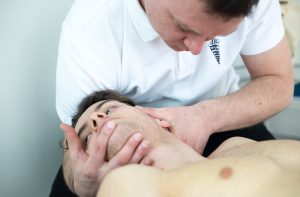 For years, I’ve been struggling with neck pain that radiates down to my left shoulder, all the way along the spine between the shoulder blades. I’ve had an X-ray of my cervical spine taken, and I kindly ask you to explain the findings to me. Lately, I’ve been experiencing a kind of dizziness, a strange sensation in my head, and a tendency to sway to one side while walking.
For years, I’ve been struggling with neck pain that radiates down to my left shoulder, all the way along the spine between the shoulder blades. I’ve had an X-ray of my cervical spine taken, and I kindly ask you to explain the findings to me. Lately, I’ve been experiencing a kind of dizziness, a strange sensation in my head, and a tendency to sway to one side while walking.
Findings: Standard X-rays of the cervical spine reveal discreet dextroconvex scoliosis with straightening of the cervical lordosis. There are spondylo-deformative and spondylarrotic changes from C2 to C7. Osteochondrosis of the vertebral body endplates is observed. Narrowing of the intervertebral space at C4-C5 and more pronounced at C5-C6 is noted. There is discreet narrowing of the intervertebral space dorsally at C6-C7. Uncovertebral arthrosis from C3 to C7 is present.
Diagnosis: Bilateral cervical brachial syndrome.
The X-ray images indicate degenerative changes in the cervical spine, which are elaborately described. The findings do not directly indicate the cause of the problem, nor can X-rays do so (except in rare cases of fractures, tumors, and some others).
Symptoms of chronic vertebral pathologies, in this case neck pain, are associated with a variety of causes. A sedentary lifestyle, lack of physical activity, particularly adequate exercise, potential excess weight, and consequently poor circulation and lack of stimulation of bone and surrounding soft tissue metabolism, stimulate degenerative changes, which then occur more rapidly, comprehensively, and produce more symptoms. Simply put, everything in nature either grows or decays, including our tissues that we do not use.
The described discomfort can be alleviated with medication, sometimes responding well to conventional therapy (electricity, ultrasound, laser, magnet), but such improvements are transient. This is because degenerative processes have altered the shape and relationships between bones and soft tissues in the neck. Additional assistance in this case may include mobilization and manipulation techniques from the field of manual medicine. However, the most common permanent solution is regular exercise, which will maintain the mobility of the cervical and thoracic spine, stimulate circulation, and strengthen, and then maintain, the muscles to be strong and resilient.
Top of Form
a.
